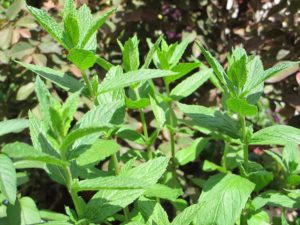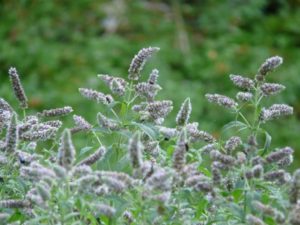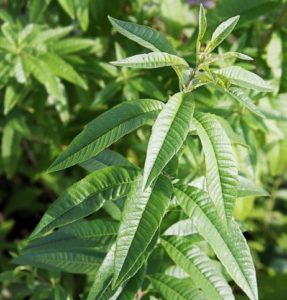Iced Tea Pots
Here’s an idea for an herb pot that’s perfect for these hot, humid days of summer. Grow herbs that you can use in iced tea! These iced tea pots will flavor your drinks all summer long.
The Plants
Spearmint
First decide which mints you like. Spearmint (Mentha spicata) is a popular mint for iced tea and other drinks. There are several hybrids you can choose from, including ‘Kentucky Colonel’, ‘Mojito’, and ‘Julep’. Mint ‘Julep’ (photo, above) is my favorite; a pot that I brought from Maryland when I moved here several years ago is still in the front yard. And it is still growing in the pot.
“Common mint”, “garden mint”, or “mint” refer to spearmint, M. spicata, unless a variety has been indicated. This species originated in the area from Ireland to southern China.
Mentha x gracilis is a sterile hybrid cultivated for its essential oils. This is the flavorful ingredient in spearmint chewing gum.
Most mints are winter hardy in USDA hardiness zones 4 through 9 and have wide distribution around the globe. Species and their interspecific hybrids are native to Europe, Asia, Africa, Australia, and North America.
Peppermint
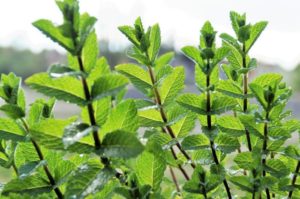
Peppermint.
Peppermint (Mentha x piperita), including chocolate peppermint and a white variegated form, is another perennial mint. Variegated peppermint is beautiful, but the white sections scorch easily in hot sun.
Use peppermint in drinks and salads, and to help calm a queasy stomach.
This mint is an interspecific hybrid between Mentha aquatica (water mint) and M. spicata (spearmint). Anyone who enjoys some cool chocolate chip mint ice cream on a hot summer day will also like chocolate peppermint.
Other Mints
And there’s orange mint, apple mint, pineapple mint, and Corsican mint, and many others. Gardeners can choose from among two dozen species and hundreds of varieties! They hybridize freely, although some of the seedlings can have an unpleasant taste. It’s best not to let them seed about.
Flowers appear at the tips of the stems. After letting the pollinators enjoy them for a couple of days, cut the stems back almost to the soil surface to prevent seeding and to encourage a flush of new growth.
Caution!
Anyone familiar with the invasive nature of mint gasps at the thought of growing it in the ground. Mint is an aggressively spreading perennial, and its mission in life is to cover the earth! Given moist, rich soil, it spreads by underground stems, called rhizomes. They multiply and spread in every direction.
The runners growing above ground will root wherever they touch the soil. I hope I’ve made my point. Unless you want them to take over, restrain them by keeping them in pots.
I’ve read articles that recommend keeping mint in a pot and burying the pot most of the way in the ground. This is supposed to prevent the rhizomes from escaping the confines of the pot. But rhizomes will pop up again unless the pot is very deep. And runners that grow over the edge of the pot will root into the surrounding soil unless they are relentlessly clipped back.
Lemon Balm
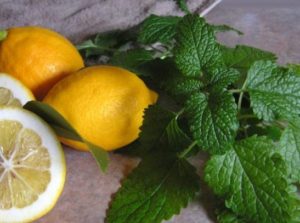
Another mint relative, lemon balm.
Lemon balm (Melissa officinalis), also in the mint family, has a cool lemon scent and flavor, and can be used in the kitchen when lemon is called for. There has been some promising research in Alzheimer’s disease using lemon balm.
A patch of lemon balm grew in the Maryland back yard. I cut it back hard to control the growth for most of the summer. Then, late in the season, I let it go to flower and to seed for the American goldfinches. They landed on the flexible stems and bobbed up and down as they extracted the seeds.
Lemon Verbena
Now, if you like a really strong lemon flavor, and growing a lemon tree is out of the question, look for lemon verbena (Aloysia triphylla). It grows somewhat on the weedy side unless it’s trimmed back once in a while. It will sprout again along the stems, as long as the roots are healthy.
Lemon verbena is native to South America and is hardy in zones 8 or 9 through 10 or 11. So, here in the piedmont of the Carolinas, this woody herb might survive a mild winter, although it will drop its leaves.
If you want to try growing it as a perennial, plant it in a warmer microclimate provided by a south-facing wall, and mulch it. Give it some time to re-leaf, as it can be a little slow.
Keep the soil moist. When watering, splash the leaves (top and bottom surfaces) to drown spider mites, which can be troublesome on this plant.
Stevia
If you like a little sweetness in your tea, add stevia (Stevia rebaudiana) to the mix. This is a summer annual throughout most of the country, but, with proper care, it can be grown in a sunny window in the winter. Stevia, or “sweet herb”, has been cultivated for a thousand years in South America.
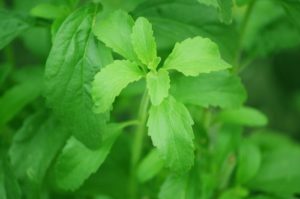
Stevia.
This herb is many, many times sweeter than table sugar. Clip a few leaves or a small stem, mash it in your hand, and add to the tea. You can also pick healthy leaves, dry them, and pulverize them to add to your drinks and to baking. But remember the higher potential it has for sweetening.
Cut back stevia to a few inches above the soil surface when it flowers to encourage new stems to grow. It will self-seed if you let the seedpods mature.
Stevia is hardy in zones 9 through 11.
Start With A Pot and Potting Soil
Soil in plastic and ceramic pots stays moist longer than soil in terra cotta pots, but clay pots are preferred by many gardeners. Most likely, you’re going to have to water your iced tea pots every day anyway. So just use a pot you enjoy seeing.
A clay pot can be lined with a plastic bag, with a few holes punched in the bottom for drainage. This will keep moisture in the soil a little longer.
A pot at least 12″ in diameter will accommodate 3-4 4″ pots. Pots with wide openings will produce the nicest looking plantings.
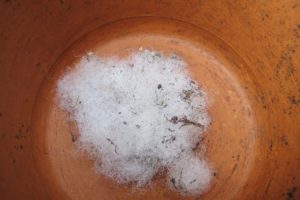
Polyester fiberfill covers the drainage hole.
Put a small handful of polyester fiberfill (available at craft stores) over the drainage hole. This prevents soil from eroding through the hole while allowing excess water to drain. It also prevents insects or worms from entering it. An alternative is to use a piece of landscape fabric, cut to cover the hole or the inside bottom of the pot. If there are several small holes in the bottom of the pot, it’s not necessary to use a filter.
Now add potting soil, lightly firming it as you proceed. Fill to within 2″ or 3″ of the rim of the pot. The soil should contain peat moss, which holds water. Pine fines, perlite, lime, starter fertilizer, and a wetting agent are also included in most bagged soil products. Adding compost to the mix will enrich the medium if it isn’t already included. These foliage plants enjoy a nutrient-rich potting soil.
When I grow and sell iced tea pots, I plant one stevia, one or two mints, and something lemony. So, all the flavor groups were covered: mint, lemon, and sweet.
Add the Plants
Starting at the back of the pot, plant the lemon verbena. Remove it from its pot, score the outside of the root ball with a knife if it’s heavily rooted, scoop out a hole for the roots, and plant. Firm the soil around the roots so that the top of the root ball (the plant’s soil surface) is an inch or two below the rim of the pot. That reservoir will hold water until it seeps into the soil. Avoid placing potting soil all the way to the top of the pot.
Now plant the stevia in the same manner, also toward the back of the pot, or in the center.
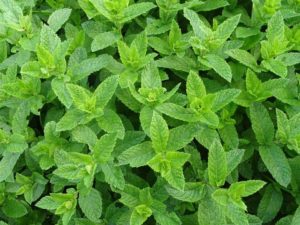
Mint.
For the mint—or the mints—place them inside the front of the pot. Mint spreads and doesn’t grow as tall as the lemon verbena or the stevia, as it will be cut back periodically.
Firm the soil around all the plants. If the soil level settled too low, simply tuck in more soil under the roots. Finish off the pot by adding a layer of mulch, such as pine fines, which helps slow down evaporation. And it looks good. Water the pot to settle in all the plants.
Many customers have expressed concern about the flavors losing their identities because the roots are growing together in the pot. Not to worry; peppermint will always taste like peppermint. Keep the labels next to the plants, to identify the particular flavor you want. Sure, if a spearmint leaf rubs against a stevia leaf, you might get a faint taste of mint with the stevia. But it’ll wash off, and it’s always a good idea to rinse herbs and vegetables before consuming them.
Maintenance
Light
Your iced tea pot needs direct sunlight for at least half the day. If the weather is cool where you live, the plants can take—and prefer—full sun (6 hours or more). Once the temperatures start getting into the 80’s F or higher, place the pot where it gets morning and early afternoon sun, and light shade during the hottest hours.
If the plants are not getting enough direct sunlight, the stems will be thin and weak. They might give you some leaves or stems to clip, but will not regrow exuberantly, and could die off.
If the plants are weakened from lack of sun, cut them back, place them in more hours of direct sun, and cross your fingers. Usually the plants recover, but sometimes they don’t. When they do start to regrow, make sure they are getting enough water, as the demand for it will increase.
Water
These plants grow fast in warm weather. They will need frequent and deep watering to prevent wilt.
Once the roots grow throughout the pot, the plants will demand watering once or twice a day on warm, sunny days. Not just a cupful or two, either. It’ll be more like 3 or 4 quarts of water for a 12″ pot, and 3 gallons or more for a half whiskey barrel. Provide enough water to moisten the entire root ball, or until it starts seeping out through the drainage holes.
If water rushes out of the bottom of the pot immediately after watering, check to make sure the soil is firmed all the way around the pot. The water found the quickest exit, which is usually through an air channel in the soil, often along the inside surface of the pot.
In hot, breezy weather, it would be a good idea to keep a saucer under smaller pots. Let the excess water in the saucer get soaked up by the roots for up to an hour after watering. If it is absorbed by the roots quickly, then add more water.
Don’t, however, keep water in the saucer all the time. That could start rotting the roots, especially if the pot is kept in less than ideal sun. It might be a good idea to move the plants into a bigger pot if the plants wilt frequently. Or reduce the top growth (cut back) to slow the amount of water lost due to transpiration.
Always check the temperature of the water when it first comes out of the hose. It will be very hot if the hose has been kept in the sun. Too hot for plants!
Fertilizer
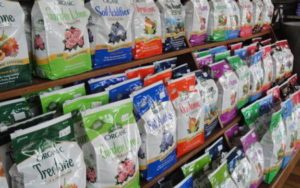
Espoma has many formulations of organic fertilizers.
Old leaves or those with poor color taste bitter or off-flavor. Fast-growing leafy herbs require fertilizer, especially nitrogen, every 2 or 3 weeks. Those include mint, basil, parsley, cilantro, and arugula.
I know; that’s contrary to what you might have heard from other gardeners. “Never fertilize your herbs; they’ll lose all their flavor.” Well, I disagree. Plants growing in pots don’t have the option of sending their roots a few feet away in search of nitrogen. They rely on you to provide it.
Since these are foliage plants, they need more nitrogen than they need other nutrients. Nitrogen (“N” on the package) is necessary for the formation of chlorophyll, the green pigment that gives leaves their characteristic color.
Both organic products and synthetics break down to the same or very similar compounds before the plant can use them. Plant-Tone and Garden-Tone are mild organic products from Espoma. High-nitrogen fish emulsion, earthworm castings, and Neptune’s Harvest are some of the organic products I use frequently.
Organic fertilizers also provide beneficial microbes, which break down organic matter in the soil and help the roots absorb nutrients and water more efficiently. Products containing microbes should be buried in the soil or covered with mulch, and watered in after application. Ultraviolet light from the sun kills microbes.
If plants are in need of a quick injection of nutrients, I have no problem using one of the soluble synthetics. Also, timed-release fertilizer products can be used if you tend to forget calendar reminders. If the product says “will fertilize 4 full months”, remember that the nutrients will be released faster in rainy or hot weather. Four months at 70 degrees would be about half that duration at 85 or 90 degrees. I often use a more expensive product that lasts “8 months”.
Pruning
The only way to keep mint looking beautiful and healthy is to cut it back regularly. When you harvest a stem, cut it almost all the way back to the soil, and use the good leaves at the tip. If you harvest stems frequently, and cut the stems hard (down to within 1/2″ to 1″ of the soil) each time, the plant will continually send up new growth from the base of the plant.
If you don’t use them often, the mints will start to look sickly, particularly in hot weather. Insects, mites, hot weather, and the occasional drought are stresses that take their toll. The plants will regrow beautiful new leaves for you. They just need a little encouragement. In fact, you can give the mints, including the lemon balm, a severe trim, cutting all of them to within 1″ of the soil if the pot is in need of rejuvenation. As long as the roots are healthy, the plants will bounce back from the underground rhizomes in a short period of time.
Lemon verbena and stevia will respond in the same way, just a little more slowly. Don’t cut them all the way down as you would cut mint. Just shape them up, or cut them back halfway, rinsing, harvesting, and drying the healthy leaves for future use.
Insects
Hot weather does bring out the beasts! You might see aphids, thrips, white flies, mealybugs, and little moth caterpillars rolled up in the leaves. As thrips scrape the cells on the leaf surface and collect the sugary sap, small scars become visible.
Most aphids can be dislodged with a strong spray from the hose. Horticultural oil will smother most insects and mites. Bacillus thuringiensis, or Bt, will get the caterpillars you might miss. If you want to use the clippings in your tea, rinse the foliage after spraying. These products are safe to use on edibles but remember to always read package directions.
Spider Mites
Tiny spider mites (arachnids, not insects) cause the characteristic stippling of the leaf surface as they feed on the reverse. Mites are easily drowned by occasionally spraying with water on the bottom of the foliage.
Overwintering
 During cold weather, place the pot next to the south side of the house (northern hemisphere), and cover with a deep layer of leaves or pine needles. Partially planting the pot in the ground (“heeling in”) will better insulate the root system from extreme cold. The mints usually regrow a second season, but, most likely, stevia and lemon verbena will need to be replanted.
During cold weather, place the pot next to the south side of the house (northern hemisphere), and cover with a deep layer of leaves or pine needles. Partially planting the pot in the ground (“heeling in”) will better insulate the root system from extreme cold. The mints usually regrow a second season, but, most likely, stevia and lemon verbena will need to be replanted.
The root ball will be a solid mass of roots and rhizomes, which can be divided in the spring. Pot up some extras in case all the divisions you planted are of the same variety. Or wait until they emerge from dormancy, when you can more easily identify the varieties.
Refresh the soil, add more plants if you choose, and you’ll have another season to enjoy your iced tea pots!
When returning home from a hot day at work, I used to pick a stem from the potted mint ‘Julep’ sitting by the front door. A glass of freshly brewed iced tea, some lemon, stevia, and mint—how refreshing is that?!

